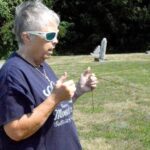Two Bowling Green ladies use dowsing to mark old graves
The ancient art has its roots in physics
Bowling Green Times – By Stan Schwartz Aug 2, 2023
To get a good reading when they’re dowsing—or witching as Audrey Jones and Donna Carver like to call it—they use a blend of science and emotion.
The two ladies, who are with the Pike County Genealogical Society and Jail Museum, discovered they had a talent for witching years ago.
Jones uses two rods and Carver uses one. Recently, Jones put on a dowsing demonstration at the Bowling Green City Cemetery along N. Main Cross. Once just a family cemetery, Jones said, it grew over time into the final resting place for many of Bowling Green’s citizens.
During those years, she said, many of the older grave markers wore away or were buried under the advancing greenery. Some graves, she explained, are not properly marked. At the back of the cemetery, there are depressions and mounds where Jones says people are buried.
“I never thought I could do this,” Jones said. Her first try at witching was a disapointment—nothing happened when she was handed the rods, which are actually repurposed wire clothes hangers bent into an L-shape.
“You have to be in the right frame of mind for them to work,” Jones explained.
She was taken to her great uncle’s, Mathias McGirk’s gravesite in Lyman, Mo. The state had put a concrete slab over the site, she said, because he was the state’s first chief justice.
“He took care of my grandmother,” she said, as a guardian after her mother died. Jones was shown then how witching worked when the graves of McGirk and his wife and child under the slab were outlined from above. They also located a baby’s grave at the edge of the slab.
Last week, she drove to the back of the Bowling Green City Cemetery, which at one time was considered the “Black” area.
Finding and marking these graves, she said, is important because she doesn’t want the people who are buried without markers to be forgotten. She wishes the city had taken over the cemetery early on, so that there would be better records of who is buried there.
Preparing to witch
Jones sets the rods in her hands, so they can move on their own. Even though it was a breezy day, she said, the wind would not be a factor in how the rods moved.
As she held them up, they started moving back and forth on their own.
“They’re already searching on their own,” she said.
Jones started at the edge of the road that runs through the cemetery and moved out over a mound. As the two rods crossed, she said, they indicated that she was in the middle of a grave.
In his book, “The Art of Dowsing,” Michael Fercik separates science from superstition, as he explains the physics behind dowsing. Each element in the periodic chart has some magnetic flux, and the human body produces just enough static electricity to affect how the rods move over those elements, he reported.
For Jones, she said, it takes belief that it’s going to work for the rods to move for her.
As she continued to walk, the rods uncrossed. Because of the length of the grave, she said, whoever is buried there was an adult. For some witchers, she said, the dowsing rods move in the opposite direction, opening outward to touch one’s shoulders. She moved back to the center of the grave and walked its width to see how wide the grave was.
“They come open pretty quick,” she added, when determining the width.
When witching with Carver, Jones said, Carver can locate a grave, and then she would come in and determine its length and width, which they mark with flags.
“A man is buried here,” she said.
It took her years to realize that she could also determine the sex of the person buried below by which rod crossed over top of the other one.
Jones walks in a grid pattern to make sure she doesn’t miss any possible graves.
“God knows why I do it,” she said. “Because I don’t want them to be forgotten.” Standing at one end of the grave, she added that she’d like to see a marker placed there. And there may be a marker there, just under the surface, buried over time.
“We can go as deep as 6 inches,” she noted. They have found some in perfect condition.
Recently, Jones and Carver mapped out the burial plots at a family cemetery. She explained that the graves of slaves were usually placed outside a family cemetery. Working together that day, Jones and Carver located 25 unmarked graves.
“When you’re out in the woods looking at a family cemetery, you definitely want to get it all,” she said. Finding and marking the graves is satisfying for Jones.
Taking care of those who have gone before us is sure sign of how civilized a society is. In Michael Frost’s article about death, he writes, “You can tell a lot about a society in the way it treats its dead bodies.” Many cultures revere and prepare their dead before burial.
Jones said she didn’t learn that she had the talent for witching until her late 30s. She’s been working in genealogy since the late 1970s
She also noted that several of the Bowling Green City Cemetery monument stones that were broken were removed years ago and piled over in a corner.
They have a book at their office that shows where many family cemeteries are located.
The Pike County Genealogical Society & Jail Museum is located at 5 East Church Street
Bowling Green, MO 63334. It is open from 1 – 4 p.m. Thursdays. They can be reached at 573-324-5810.

